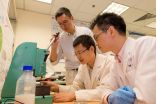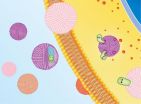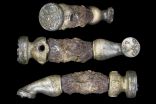(Press-News.org) Scientists from Nanyang Technological University (NTU Singapore) have developed a new battery that can be recharged up to 70 per cent in only 2 minutes. The battery will also have a longer lifespan of over 20 years.
Expected to be the next big thing in battery technology, this breakthrough has a wide-ranging impact on many industries, especially for electric vehicles which are currently inhibited by long recharge times of over 4 hours and the limited lifespan of batteries.
This next generation of lithium-ion batteries will enable electric vehicles to charge 20 times faster than the current technology. With it, electric vehicles will also be able to do away with frequent battery replacements. The new battery will be able to endure more than 10,000 charging cycles – 20 times more than the current 500 cycles of today's batteries.
NTU Singapore's scientists replaced the traditional graphite used for the anode (negative pole) in lithium-ion batteries with a new gel material made from titanium dioxide, an abundant, cheap and safe material found in soil. It is commonly used as a food additive or in sunscreen lotions to absorb harmful ultraviolet rays.
Naturally found in a spherical shape, NTU Singapore developed a simple method to turn titanium dioxide particles into tiny nanotubes that are a thousand times thinner than the diameter of a human hair.
This nanostructure is what helps to speeds up the chemical reactions taking place in the new battery, allowing for superfast charging.
Invented by Associate Professor Chen Xiaodong from the School of Materials Science and Engineering at NTU Singapore, the science behind the formation of the new titanium dioxide gel was published in the latest issue of Advanced Materials, a leading international scientific journal in materials science.
NTU professor Rachid Yazami, who was the co-inventor of the lithium-graphite anode 34 years ago that is used in most lithium-ion batteries today, said Prof Chen's invention is the next big leap in battery technology.
"While the cost of lithium-ion batteries has been significantly reduced and its performance improved since Sony commercialised it in 1991, the market is fast expanding towards new applications in electric mobility and energy storage," said Prof Yazami.
Last year, Prof Yazami was awarded the prestigious Draper Prize by the National Academy of Engineering for his ground-breaking work in developing the lithium-ion battery with three other scientists.
"There is still room for improvement and one such key area is the power density – how much power can be stored in a certain amount of space – which directly relates to the fast charge ability. Ideally, the charge time for batteries in electric vehicles should be less than 15 minutes, which Prof Chen's nanostructured anode has proven to do."
Prof Yazami, who is Prof Chen's colleague at NTU Singapore, is not part of this research project and is currently developing new types of batteries for electric vehicle applications at the Energy Research Institute at NTU (ERI@N).
Commercialisation of technology
Moving forward, Prof Chen's research team will be applying for a Proof-of-Concept grant to build a large-scale battery prototype. The patented technology has already attracted interest from the industry.
The technology is currently being licensed to a company and Prof Chen expects that the new generation of fast-charging batteries will hit the market in two years' time. It holds a lot of potential in overcoming the longstanding power issues related to electro-mobility.
"With our nanotechnology, electric cars would be able to increase their range dramatically with just five minutes of charging, which is on par with the time needed to pump petrol for current cars," added Prof Chen.
"Equally important, we can now drastically cut down the waste generated by disposed batteries, since our batteries last ten times longer than the current generation of lithium-ion batteries."
The long-life of the new battery also means drivers save on the cost of a battery replacement, which could cost over USD$5,000 each.
Easy to manufacture
According to Frost & Sullivan, a leading growth-consulting firm, the global market of rechargeable lithium-ion batteries is projected to be worth US$23.4 billion in 2016.
Lithium-ion batteries usually use additives to bind the electrodes to the anode, which affects the speed in which electrons and ions can transfer in and out of the batteries.
However, Prof Chen's new cross-linked titanium dioxide nanotube-based electrodes eliminate the need for these additives and can pack more energy into the same amount of space.
"Manufacturing this new nanotube gel is very easy," Prof Chen added. "Titanium dioxide and sodium hydroxide are mixed together and stirred under a certain temperature. Battery manufacturers will find it easy to integrate our new gel into their current production processes."
INFORMATION:
This battery research project took the team of four NTU Singapore scientists three years to complete and is funded by Singapore's National Research Foundation.
NTU Singapore is a young, research-intensive Asian university that is ranked No. 1 in the world in this year's QS Top 50 Under 50 rankings, a global league table of young universities 50 years old and below.
It has an established track record for working with industry. In the 2013 and 2014 Times Higher Education World University Rankings 2014, NTU Singapore was ranked joint No. 1 globally for industry income and innovation with a few other universities.
NTU Singapore is also one of the biggest risers in the latest Times Higher Education World University Rankings, leaping 15 notches this year to 61st position. It has moved up the prestigious league table a total of 108 places in the last three years, making it the best performer in the top 200 in recent times.
Media contact:
Lester Kok
Senior Assistant Manager
Corporate Communications Office
Nanyang Technological University
Tel: 6790 6804; HP: 9741 5593
Email: lesterkok@ntu.edu.sg
About NTU Singapore
NTU Singapore is a young, research-intensive university on a rapid global rise. Its eco-friendly campus, named one of the World's 15 Most Beautiful Campuses, is home to 33,000 undergraduate and postgraduate students in the colleges of Engineering, Business, Science, and Humanities, Arts, & Social Sciences. In partnership with Imperial College London, NTU Singapore has a new medical school, the Lee Kong Chian School of Medicine.
Helmed by Professor Bertil Andersson, winner of the Wilhelm Exner Medal, an honour bestowed on the world's best scientists, the University is a melting pot of international award-winning scientists, young talents and eminent global partners such as BMW, Rolls-Royce and Lockheed Martin.
NTU Singapore has several world-class national institutes – the National Institute of Education, S Rajaratnam School of International Studies, Earth Observatory of Singapore, and Singapore Centre on Environmental Life Sciences Engineering – and various leading research centres such as the Nanyang Environment & Water Research Institute, Energy Research Institute @ NTU and the Institute on Asian Consumer Insight.
A cosmopolitan university with more than 100 nationalities, NTU has three campuses - its main Yunnan Garden campus, a satellite campus in Singapore's science and tech hub, one-north, and a third campus in Novena, Singapore's medical district.
For more information, visit http://www.ntu.edu.sg. For a quick tour of the campus, watch this video.
Follow us on Facebook, Twitter, YouTube and LinkedIn.
Ultra-fast charging batteries that can be 70 percent recharged in just 2 minutes
NTU Singapore behind the next big thing in batteries
2014-10-14
ELSE PRESS RELEASES FROM THIS DATE:
Older women more likely to have multiple health conditions
2014-10-14
In the context of an aging population, the number of cases of people with multimorbidity, or multiple health conditions, is increasing, creating significant healthcare challenges. Now, the first comprehensive systematic review in this field has found higher levels of multimorbidity in women. Equally as importantly, it has revealed the poor quality of evidence on this increasingly critical area of healthcare.
The review's main author, Professor Jose M Valderas, NIHR Clinician Scientist of the University of Exeter Medical School, is calling for better quality research to ...
Bio-inspired 'nano-cocoons' offer targeted drug delivery against cancer cells
2014-10-14
Biomedical engineering researchers have developed a drug delivery system consisting of nanoscale "cocoons" made of DNA that target cancer cells and trick the cells into absorbing the cocoon before unleashing anticancer drugs. The work was done by researchers at North Carolina State University and the University of North Carolina at Chapel Hill.
"This drug delivery system is DNA-based, which means it is biocompatible and less toxic to patients than systems that use synthetic materials," says Dr. Zhen Gu, senior author of a paper on the work and an assistant professor in ...
Cushing's syndrome: LCSB researchers characterize a new tumor syndrome
2014-10-14
Scientists at the Luxembourg Centre for Systems Biomedicine (LCSB) of the University of Luxembourg have published their findings that mutations in a gene known as "ARMC5" promote the growth of benign tumours in the adrenal glands and on the meninges: ARMC5 appears to belong to the group of so-called tumour suppressor genes. It is the first time in years that scientists have characterized such a gene.
The ARMC5 gene was discovered by independent workgroups studying benign tumours – so-called adrenal adenomas – in connection with Cushing's syndrome. In this ...
University of Leicester archaeologists discover bronze remains of Iron Age chariot
2014-10-14
University of Leicester archaeologists have made a "once-in-a-career" discovery of the decorated bronze remains of an Iron Age chariot.
A team from the University's School of Archaeology and Ancient History has unearthed a hoard of rare bronze fittings from a 2nd or 3rd century BC chariot which appears to have been buried as a religious offering.
The archaeologists found the remains during their ongoing excavation of the Burrough Hill Iron Age hillfort, near Melton Mowbray, Leicestershire.
The School has led a 5-year project there since 2010, giving archaeology students ...
Disputed theory on Parkinson's origin strengthened
2014-10-14
Parkinson's disease is strongly linked to the degeneration of the brain's movement center. In the last decade, the question of where the disease begins has led researchers to a different part of the human anatomy. In 2003, the German neuropathologist Heiko Braak presented a theory suggesting that the disease begins in the gut and spreads to the brain. The idea has since, despite vocal critics, gained a lot of ground. Researchers at Lund University in Sweden now present the first direct evidence that the disease can actually migrate from the gut to the brain.
The so-called ...
Magnetic superconductor: Strange bedfellows
2014-10-14
Chemists at Ludwig-Maximilias-Universitaet (LMU) in Munich have synthesized a ferromagnetic superconducting compound that is amenable to chemical modification, opening the route to detailed studies of this rare combination of physical properties.
Superconductivity and ferromagnetism – the "normal" form of magnetism, such as that found in the familiar horseshoe magnet – are like chalk and cheese: They generally don't go together. Ferromagnets are magnetic because the parallel alignment of adjacent electron spins in the iron atoms generates a strong internal ...
Rising sea levels of 1.8 meters in worst-case scenario
2014-10-14
The climate is getting warmer, the ice sheets are melting and sea levels are rising – but how much? The report of the UN's Intergovernmental Panel on Climate Change (IPCC) in 2013 was based on the best available estimates of future sea levels, but the panel was not able to come up with an upper limit for sea level rise within this century. Now researchers from the Niels Bohr Institute and their colleagues have calculated the risk for a worst-case scenario. The results indicate that at worst, the sea level would rise a maximum of 1.8 meters. The results are published ...
The chemistry of pizza (video)
2014-10-14
WASHINGTON, Oct. 13, 2014 — Whether it's a plain cheese, a deep-dish stacked with meats or a thin-crust veggie delight, there's just something about pizza that makes it delicious. There's a lot of chemistry that goes into everything from dough to sauce to toppings to, of course, cheese. There's also a very specific chemical reaction at work on every single slice, no matter what toppings you choose. Check out the latest episode here: http://youtu.be/tOkCgAwhh9U.
Subscribe to the series at Reactions YouTube, and follow us on Twitter @ACSreactions to be the first to ...
Oral drug reduces formation of precancerous polyps in the colon, UB researchers find
2014-10-14
BUFFALO, N.Y. — An oral biologic medication has successfully treated chronic, precancerous inflammation in the intestine, according to results of an animal study authored by an MD/PhD student in the University at Buffalo School of Medicine and Biomedical Sciences.
The study is featured on the cover of the current issue of Cancer Research; it was published online ahead of print in September. The journal's editors characterized the study's findings as "striking."
Inflammatory cells in the colon, or polyps, are very common after the age of 50. The average 60-year-old ...
NASA satellite sees wind shear affecting Tropical Storm Vongfong
2014-10-14
Tropical Storm Vongfong continues to weaken as it tracks across the big islands of Japan, and NASA satellite data showed that westerly wind shear is taking its toll on the storm's structure.
On Oct. 12 at 0500 UTC (1 a.m. EDT), the MODIS instrument aboard NASA's Aqua satellite captured an image of Tropical Storm Vongfong approaching Japan. Despite weakening to a tropical storm, Vongfong still appeared to have an eye as its northeastern quadrant blanketed the large island of Kyushu, Japan. By 11 a.m. EDT, Maximum sustained winds had dropped to 55 knots (63 mph/102 kph). ...
LAST 30 PRESS RELEASES:
Heart-brain connection: international study reveals the role of the vagus nerve in keeping the heart young
Researchers identify Rb1 as a predictive biomarker for a new therapeutic strategy in some breast cancers
Survey reveals ethical gaps slowing AI adoption in pediatric surgery
Stimulant ADHD medications work differently than thought
AI overestimates how smart people are, according to HSE economists
HSE researchers create genome-wide map of quadruplexes
Scientists boost cell "powerhouses" to burn more calories
Automatic label checking: The missing step in making reliable medical AI
Low daily alcohol intake linked to 50% heightened mouth cancer risk in India
American Meteorological Society announces Rick Spinrad as 2026 President-Elect
Biomass-based carbon capture spotlighted in newly released global climate webinar recording
Illuminating invisible nano pollutants: advanced bioimaging tracks the full journey of emerging nanoscale contaminants in living systems
How does age affect recovery from spinal cord injury?
Novel AI tool offers prognosis for patients with head and neck cancer
Fathers’ microplastic exposure tied to their children’s metabolic problems
Research validates laboratory model for studying high-grade serous ovarian cancer
SIR 2026 delivers transformative breakthroughs in minimally invasive medicine to improve patient care
Stem Cell Reports most downloaded papers of 2025 highlight the breadth and impact of stem cell research
Oxford-led study estimates NHS spends around 3% of its primary and secondary care budget on the health impacts of heat and cold in England
A researcher’s long quest leads to a smart composite breakthrough
Urban wild bees act as “microbial sensors” of city health.
New study finds where you live affects recovery after a hip fracture
Forecasting the impact of fully automated vehicle adoption on US road traffic injuries
Alcohol-related hospitalizations from 2016 to 2022
Semaglutide and hospitalizations in patients with obesity and established cardiovascular disease
Researchers ‘listen in’ to embryo-mother interactions during implantation using a culture system replicating the womb lining
How changing your diet could help save the world
How to make AI truly scalable and reliable for real-time traffic assignment?
Beyond fragmented markets: A new framework for efficient and stable ride-pooling
Can shape priors make road perception more reliable for autonomous driving?
[Press-News.org] Ultra-fast charging batteries that can be 70 percent recharged in just 2 minutesNTU Singapore behind the next big thing in batteries






